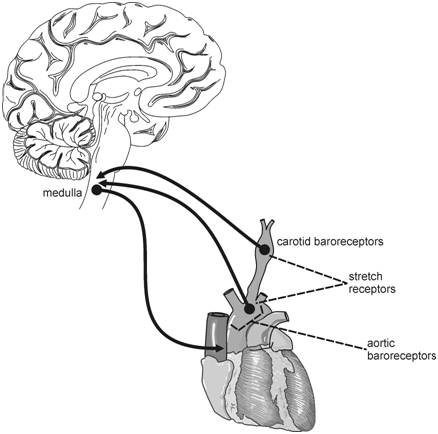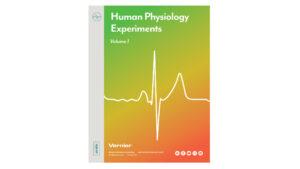
Introduction
One of the homeostatic mechanisms of the human body serves to maintain a fairly constant blood pressure. Major determinants of blood pressure are heart rate, amount of blood pumped with each beat (stroke volume), and the resistance of the arterial system which is receiving the blood. The heart rate is influenced by baroreceptors, special sensors in tissues in the aortic arch and carotid arteries which contain nerve endings that respond to stretching (see Figure 1). An increase or decrease in stretch sends signals to the medulla in the brain which in turn acts on the heart through the vagus nerve, completing what is called a feedback loop. Sudden increase in pressure in the heart or carotid arteries causes an increase in stretch of the baroreceptor sensors and results in a decrease in heart rate. Sudden lowering of pressure causes the opposite effect. This feedback loop enables us to function as blood pressure changes with body position and external forces such as gravity.
Most people have experienced the sensation of dizziness after standing abruptly from a seated or squatting position. This effect can be seen in healthy individuals, but it is accentuated in the elderly and in certain conditions including dehydration and Parkinson’s disease. In these cases, the increase in heart rate may be significant but is still not able to make up for an insufficiency of the other two contributors to blood pressure (i.e., low blood volume or poor regulation of the resistance of the arterial system by the sympathetic nervous system). One of the first tests performed by doctors on patients who complain of dizziness is to check the blood pressure and pulse with the patient lying down and then standing. A drop in blood pressure of 20 points or an increase in heart rate of 20 points with standing is considered significant. This condition is called orthostatic hypotension.
In this experiment, you will observe heart rate response to squatting and to standing from a squatting position. In the former, there is a rapid increase in venous return to the heart as veins in the leg muscles are compressed. This causes a sudden increase in stroke volume and pressure sensed by the baroreceptors. In standing from a squatting position, there is a sudden reduction in venous return to the heart because of “pooling” of blood in the legs. This results in a decrease in stroke volume and pressure.
Objectives
- Observe pulse response to sudden squatting.
- Observe pulse response to sudden standing from a squatting position.
Sensors and Equipment
This experiment features the following sensors and equipment. Additional equipment may be required.
Correlations
Teaching to an educational standard? This experiment supports the standards below.
Ready to Experiment?
Ask an Expert
Get answers to your questions about how to teach this experiment with our support team.
- Call toll-free: 888-837-6437
- Chat with Us
- Email support@vernier.com
Purchase the Lab Book
This experiment is #6 of Human Physiology Experiments: Volume 1. The experiment in the book includes student instructions as well as instructor information for set up, helpful hints, and sample graphs and data.


